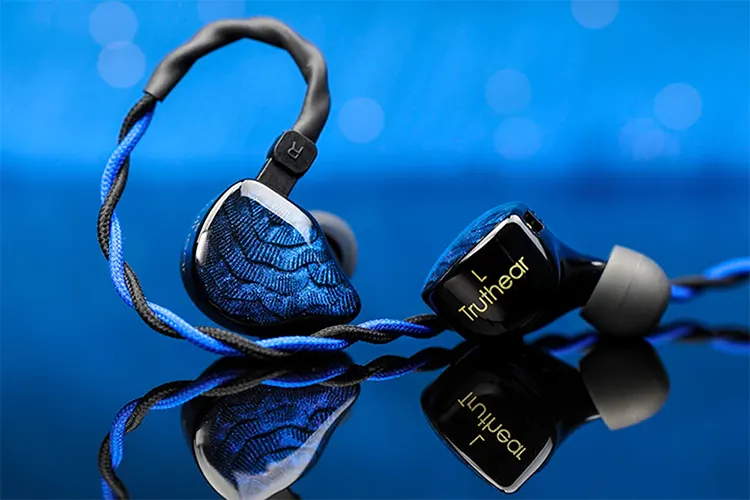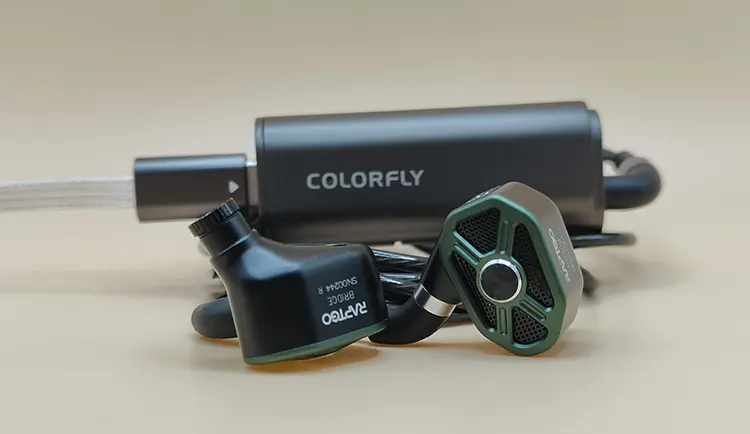Synergy
Efficiency
The Raptgo Bridge’s impedance rating changes depending on the switches you have on or off. With the standard gain, you have around 17 Ω of impedance while 34Ω of impedance with high gain.
The sensitivity is also the same. With standard gain, it has 105db of sensitivity and 109db of sensitivity for high gain.
Any device will be able to run this at sufficient volume. Buying a high-end source isn’t needed with the Raptgo Bridge, but owning a source with a well-implemented DAC would give it the best pairing possible.
Pairings
This is an unusual IEM concerning pairings. The pairings I tried would make the Raptgo Bridge sound either great or terrible.
I first tested it with a regular CX31993X dongle. Using the Raptgo Bridge with it made the mids sound incredibly wrong, making it nasally and tonally off. I then switched to the Radsone ES100. I expected better with its AK4356A DAC chipset, but sadly the result was the same.
They had the same shrill, tonally wrong, and nasally mids with either of them. I normalized the volume to around 70db with my listening for this and the rest.
Then this time I tried using the Colorfly CDA-M1P. This one uses an AK4493SEQ DAC for it, and surprisingly this time it sounded better, making the mids sound full and airy while having the correct tonality now.
The same happened when I used the Colorfly CDA-M2 as well. Why this happens might be due to chip implementation.

Select Comparisons
Truthear Nova
Technical
The Truthear Nova comes with a 1DD 4BA driver setup. It has an impedance of 14.8 ohms and a sensitivity of 123dB/Vrms.
The 14.8-ohm impedance rating of the Truthear Nova will make it an easy plug-and-play IEM for any device or source. The Truthear Nova will be easy to drive to just about any audio source.
The 123db/Vrms rating makes the Truthear Nova efficient and less choosy for its sources. You wouldn’t need to turn up the volume a lot to get the full capabilities of it.
Design
The Truthear Nova has a beautiful design. That blue seashell-like pattern on its faceplate is a sight to see or show off to others.
Aside from the wonderful faceplate, its shell has a uniform black color design. Other things to note are the 2 vents near the pin connectors and the Truthear name above it with a right or left marking next to it.
For the shape, the Truthear Nova is a large shell, which might cause issues for some users. The nozzle is long and will definitely go deep in your ears.
Lastly, it has a blue and black cable that is braided well and looks great. The issue with it is that it tangles easily.
Performance
Starting with the bass, both the Truthear Nova and the Raptgo Bridge have the same bass quality. The difference lies with the bass of the Truthear Nova being stronger.
You can feel the bass better with the Truthear Nova since it’s a star of its own unlike the Raptgo Bridge’s being more of a supportive bass. Meanwhile, the Raptgo Bridge has its bass evenly spread throughout the other areas to help its mids and treble.
The mids is a different flavor for both of them. One has an analytical approach, the other has an intimate approach.
The Truthear Nova takes on the intimate approach. The vocals are more in your head and are positioned dead in the center. The Raptgo Bridge takes on the analytical approach. Its vocals are more airy and you can hear the breathing and habits that the singer has.
The Truthear Nova vocals sound thicker and fuller, but they also have a subtle veil that impacts clarity. The Raptgo Bridge sounds thinner but has a lot more airiness and great clarity.
Comparing the treble, not much needs to be said because the Raptgo Bridge blows it out of the water completely. From having more details and sparkle, the Truthear Nova doesn’t compete with Raptgo Bridge in that regard.
There is one aspect that the Truthear Nova wins in, the sibilance control. There is nearly no sibilance with the Truthear Nova, while the Raptgo Bridge has sibilance that might be an issue to some.
Soundstage, imaging, and separation, the Raptgo Bridge automatically wins as well. The Truthear Nova doesn’t have a far-reaching soundstage width.

LETSHUOER S12 Pro
Technical
The LETSHUOER S12 Pro is a planar IEM that comes with a custom 14.8mm planar driver. The cable it comes with is a modular cable that has 2.5mm, and 3.5mm. and 4.4mm terminations.
The S12 Pro’s 14.8mm custom planar driver comes with a large diaphragm for it. LETSHUOER claims this brings great detail retrieval, bass response, and clear treble.
It has a 16-ohm impedance and 102 db/Vrms rating. In other words, any device can run but you might need to turn up the volume for it to get sufficiently loud.
Design
The design of the S12 Pro is refined, classy, and polished. Its shell, which is colored blue, looks like a fine art piece due to its similarly blue metal unibody shell.
The S12 Pro has a full aluminum chassis. Due to that, it’s also rated as IPX3 or it’s protected against water sprays at any angle up to 60 degrees from vertical.
The cables also follow its design philosophy. The color of its cable and the 2.5mm, 3.5mm, and 4.4mm are all blue as well. It’s definitely one of the classier sets out there in the market. The design fits very well for any aspects or events you might go to.
Performance
This is a battle between a planar IEM vs a multi-driver IEM. The twist in this case is that the planar IEM performs like a single dynamic driver, while the multi-driver IEM performs like a planar.
For bass, the Raptgo Bridge performs better than the S12 Pro. Having dynamic drivers makes the thump and rumble way more enjoyable.
The S12 Pro’s bass feels lacking in comparison. It does do better than the competition, but it doesn’t get close to how a dynamic driver would do bass.
Mids are simply better with the Raptgo Bridge. There is a shout with both of these sets, but there’s just too much shout with the S12 Pro. Clarity and details, it’s about the same with both of them. There is more airiness with the Raptgo Bridge though.
In treble, their detail retrieval is about the same as the S12 Pro having the edge. The difference lies with how they handle sibilance. Raptgo Bridge has less sibilance and is better for the ears. Meanwhile, the S12 Pro has a lot of sibilance which did hurt my ears.
Soundstage, imaging, and dynamics, this is simply the playground of the Raptgo Bridge. The S12 Pro is a step below the performance of the Raptgo Bridge in that regard.
The soundstage of the Raptgo Bridge just goes way farther than the S12 Pro’s. But for the imaging, it’s equal in performance, so you won’t get any difference in that aspect.
Our Verdict
The Raptgo Bridge is a good addition to the Raptgo family of IEMs. It does nearly everything well while having only what I would consider little things to nitpick at.
It’s not a basshead IEM, but it gets the job done for all other types of music. But for vocals, instruments, and soundstage, this is an absolute winner. A comfortable IEM with good looks and build quality that checks quite a few boxes, that’s the Raptgo Bridge.
RAPTGO Bridge Technical Specifications
- Driver Type: Two (2) 10mm customized dynamic drivers, two (2x) customized balanced armatures, and one (1x) 10mm double 12-layer PZT drive unit
- Plug: 3.5mm single-ended standard 0.78mm-2pin
- Frequency Response: 20Hz – 40kHz
- Impedance: 17Ω@1kHz (Standard) / 34Ω@1kHz (High Gain)
- Sensitivity: 108db SPL/mW (Standard) / 108db SPL/mW (High Gain)



